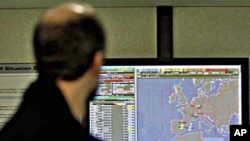What are "no-fly" zones and what is the new U.N. Security Council resolution about Libya trying to accomplish?
"No-fly" zones refer to demilitarized air space - an area which has been declared off-limits to aircraft, especially military aircraft. The tactic is most often used to suppress violence by one side in an internal or regional conflict, in order to protect civilians.
Thursday's U.N. Security Council resolution on possible military action against Libya authorized other countries to take "all necessary means" to protect civilians in the north African country.
The resolution says concerted international action may be necessary because the situation in Libya is deteriorating, violence is escalating and civilian casualties have been heavy. Security Council members agreed that "the widespread and systematic attacks currently taking place in [Libya] against the civilian population may amount to crimes against humanity."
The resolution passed unanimously by a 10-0 vote, but five of the 15 Security Council members abstained. It declared a "no-fly" zone in effect throughout Libya, but did not specify which countries would take part in enforcing this decision, or how, or who would be in charge. It specifically mentioned the need to protect civilians in Benghazi, the eastern Libyan city that has been the center of anti-Gadhafi protests.
The complex task of closing a country's skies to air traffic usually requires coordinated action by several nations. During the past 20 years, warplanes from a coalition of nations have patrolled two no-fly zones, over Bosnia-Herzegovina and over Iraq.
NATO supervised the two-year flight ban in the Balkans in the mid-1990s. The mission prevented major use of air power by any side in the Bosnian war. Twelve NATO members contributed to the operation, and NATO pilots had flown more than 100,000 sorties by the end of the war in December 1995.
A "no-fly" zone also was enforced over northern and southern Iraq after the first Gulf War in 1991 until the U.S.-led invasion of Iraq in 2003. Fighter jets from the United States, Britain and to a lesser extent, France, patrolled the skies there.
The restriction in northern Iraq aimed to prevent possible bombing and chemical attacks against Kurds in the region. The southern Iraq zone was created to protect the country's Shi'ite population.
Some countries also have implemented "no-fly" zones over their own territory. The United States, for example, closed air space around Washington, D.C., after the terrorist attacks on September 11, 2001. Some of the restrictions are still in effect, chiefly affecting unscheduled flights by small planes. The Washington "no-fly" zone is intended to protect the White House, the U.S. Capitol and other possible terrorist targets.











